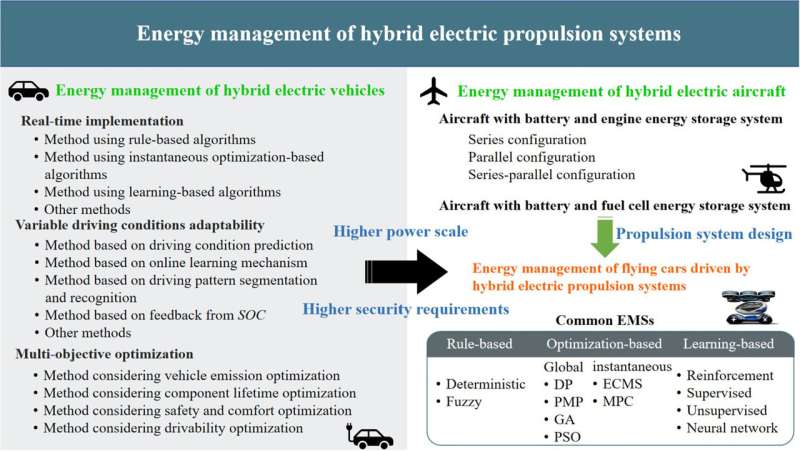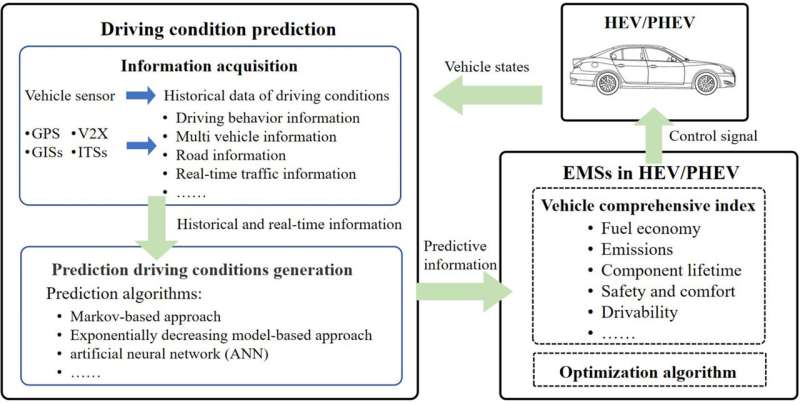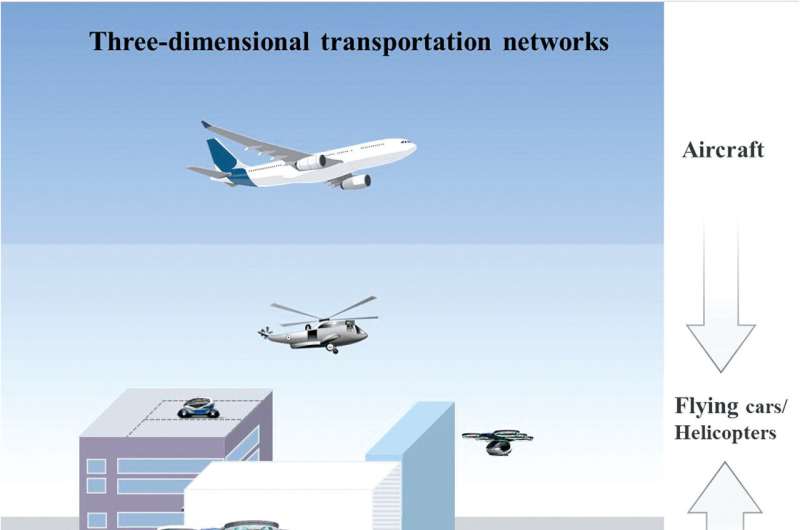This article has been reviewed according to Science X's editorial process and policies. Editors have highlighted the following attributes while ensuring the content's credibility:
fact-checked
proofread
Energy management of hybrid electric propulsion system: Recent progress and a flying car perspective

A paper aiming to provide guidance for research on the energy management strategies (EMSs) for flying cars driven by hybrid electric propulsion systems (HEPSs) by comprehensively summarizing the EMSs of HEPSs for vehicles and aircraft under three-dimensional transportation networks has been published in the journal Green Energy and Intelligent Transportation.
Over the years, the reliance on fossil fuels worldwide has dramatically exacerbated the energy shortage and pollutant emissions. The search for technologies to achieve efficient utilization of energy and net-zero emissions is being pursued with increasing intensity worldwide. Electrification of automobile and aviation industries is recognized as one of the effective ways to achieve the above objectives.
Many vehicle and aircraft manufacturers have adopted new propulsion technologies, including hybrid electric propulsion systems (HEPSs) and pure electric propulsion systems. HEPSs combining the advantages of two different energy sources are effective alternative propulsion systems until the battery technology matures.
To fulfill the above performance of the HEPS, energy management plays a critical role. Throughout the research status on energy management strategies (EMSs) of hybrid electric vehicles (HEVs) and hybrid electric aircraft, which are important components of the three-dimensional transportation network, extensive research has been developed.
Recently, the Urban Air Mobility (UAM) scenario has captured the imagination of many visionaries worldwide. The introduction of flying cars further enriches the composition of three-dimensional transportation networks. Likewise, EMSs also play a critical role in maintaining the efficient operation of flying cars driven by HEPSs. The current research on EMSs for flying cars is still in its infancy.
This paper presents an in-depth review of EMSs for HEVs and hybrid electric aircraft. First, in view of the main challenges of current EMSs of HEVs, the referenced research is reviewed according to the solutions facing real-time implementation problems, variable driving conditions adaptability problems, and multi-objective optimization problems, respectively.
Second, the existing research on the EMSs for hybrid electric aircraft is summarized according to the hybrid electric propulsion architectures. In the last part of this paper, the development status of flying cars and their future prospects are elaborated. By comprehensively summarizing the EMSs of HEPSs for vehicles and aircraft, this review aims to provide guidance for the research on the EMSs for flying cars driven by HEPSs and serve as the basis for knowledge transfer of relevant researchers.

The specific process of HEV energy management is as follows:
First, the vehicle sensor, the intelligent transportation system (ITS), or Internet of Vehicles technology is used to obtain historical data of driving conditions, driving behavior information, multi-vehicle information, and real-time traffic information.
Second, according to the above obtained historical or real-time information, the vehicle state information such as vehicle speed, acceleration, and demand power in the finite horizon is predicted by using prediction methods such as Markov chain (MC), neural network (NN), and exponentially decreasing model.
Third, based on the predicted demand power, the objective function is solved by optimization algorithms to obtain the optimal control sequence in the prediction horizon while meeting the component constraints. Generally, a variety of optimization indexes are considered, such as component lifetime, safety, comfort, etc.
Finally, the optimal control sequence is applied to the vehicle controller, and then the driving condition information is updated to re-predict the vehicle state in the finite horizon.
To realize the application of EMSs in the real world, three critical issues have been widely discussed by researchers.
- The real-time implementation problems of EMSs. The real-time performance of EMSs is the basis for its application in the real world.
- The variable driving conditions adaptability problems. The driving conditions in the real world are complex and variable. An EMS is expected to perform well in the real world. Therefore, it is necessary to ensure that the proposed EMS is effective for different driving conditions.
- Multi-objective optimization problems, such as safety, comfort, drivability, and component life. Multi-objective optimization can comprehensively consider the vehicle performance and obtain the optimal compromise control scheme between different optimization indexes.

Due to the successful application of HEPSs and pure electric propulsion systems in ground vehicles, HEPSs have also been developed in unmanned aerial vehicles (UAVs) and general aviation aircraft in recent years in recent years. HEPSs include two energy supply systems, which are more suitable for aircraft performing remote or high mobility tasks.
For aircraft, there are significant differences in the power demand for different modes, such as takeoff, cruising, and landing, and it is necessary to develop a reasonable EMS to meet the power demand of different modes. An interesting point is that fuel cell HEPSs account for a significant proportion of existing aircraft HEPS research.
To meet transportation demands in densely urbanized environments, a three-dimensional transportation network is being developed. As an important means of building a three-dimensional transportation network and realizing the UAM scenario, flying cars are a great attraction for researchers and companies. The current research on EMSs for flying cars is still in its infancy, and two factors make it more complicated.
On the one hand, the driving conditions of flying cars are highly complex, including a variety of operation modes, such as idling, forward, and braking in ground driving mode, climbing, cruising, hovering, and vertical take-off and landing in flight mode. The energy demand characteristics are significantly different in these various driving conditions.
The prediction accuracy of energy demand becomes more critical. On the other hand, the architecture of the propulsion system of flying cars determines the complexity of its energy flow distribution. In the HEPS for flying cars, the power requirements in the above different operation modes are supplied by the same battery pack and the engine generator set. Improper power distribution will worsen fuel economy and shorten the flying range.
Based on the summary and analysis of the existing research on EMSs of HEVs and hybrid electric aircraft and the discussion on the research status of flying cars, the following considerations will be beneficial to EMS research on flying cars:
- The power demand of a flying car varies significantly between the flight phase and the ground driving phase but changes little during the flight phase. The prediction of demand power plays a vital role in formulating an efficient EMS.
- The same battery pack and the engine-generator set supply the power requirements in different operation modes of a flying car. Power matching is essential for fuel economy and flying range.
- The emergency support mechanism in case of flight failure should preferably be incorporated into the formulation of the EMS for flying cars.
- The flying car is usually driven by a turboshaft engine, and its rotor adopts a constant speed. The characteristics of the turboshaft engine must be considered.
- The battery temperature and motor temperature are included in the optimization indexes to improve the safety of the flying car.
More information: Chao Yang et al, Energy management of hybrid electric propulsion system: Recent progress and a flying car perspective under three-dimensional transportation networks, Green Energy and Intelligent Transportation (2022). DOI: 10.1016/j.geits.2022.100061




















